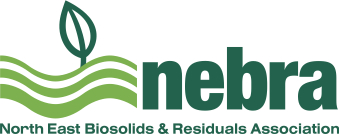The Northeast Residuals & Biosolids Conference returned to Portsmouth, NH at the beginning of November, drawing more than 130 participants to explore this year’s theme of Overcoming Challenges to Resource Recovery. Participants came from as far as California and there was a large Canadian contingent including representatives from the provinces of Nova Scotia, Quebec, and Ontario.
With decades of collaborating on this conference, it was clear the program committee had its act together. Building on last year's “solid” success, this year’s program provided additional technical insights from a diverse group of professionals who are doing the hard work of managing biosolids and residuals in the Northeast. This year's program focused on overcoming challenges to resource recovery and included some lessons learned from all around the Northeast, including Canada.
The 2023 conference kicked off with a tour of the Peirce Island water resource recovery facility, attended by about 50 people. Chief Plant Operator Peter Conroy and crew made it a worthwhile visit to this scenic island connected by bridge to the Portsmouth mainland. Later, the New England Water Environment Association (NEWEA)’s Past President Frederick McNeill, also a long-time NEBRA member and New Hampshire native, welcomed the crowd to the conference. Justin Motta, NEWEA’s Residuals & Biosolids Committee Chair, then took the reins for Day 1 of the conference which focused on big picture issues like communications, regionalization, regulation, legislation, and resource recovery. PFAS did get a mention or two on Day 1 but the final presentation by incoming NEBRA President Lise LeBlanc about her company’s work on carbon farming programs in Atlantic Canada really got people talking.
On Day 2, NEBRA’s outgoing President Deb Mahoney addressed PFAS and the collaborations and good efforts going on in the Northeast, especially in Maine. She thanked her fellow NEBRA Board members and officers and Executive Director for their active engagement in the organization. She extolled the great work going on, despite all the challenges, changes, and uncertainties. She spoke about attending the Maine Water Environment Association (MEWEA)’s conference in the fall:
“Despite the anger and resentment, MEWEA extended an olive branch to one of the farmers affected by PFAS contamination and invited him to attend the conference and have a voice. I was blown away by the sentiment and the way this farmer was welcomed into the MEWEA community. This is a true testament to the character of people in our industry. We are not the source of the problem, we are an unfortunate casualty of the politics.”
Mahoney also spoke about NEBRA’s collaboration with NEWEA on legislative advocacy efforts. She was especially excited about the collaboration with NEIWPCC on a Bio-Hub in Maine to test and pilot new technologies for biosolids processing and PFAS treatment with the goal of turning something negative into a positive. “It’s important to have an organization like NEBRA whose sole mission is to advocate and advance biosolids and residuals,” Mahoney concluded, saying she was very encouraged by “our industry, our great community of smart, passionate environmentalists, coming together, working together, pushing to be more innovative and collaborative.”
NEBRA Executive Director, Janine Burke-Wells, moderated the technical sessions as well as a diverse panel discussion on PFAS in Biosolids on Day 2. The group for the roundtable discussion included Mickey Nowak (Massachusetts Water Environment Association), Tiffany Skogstrom (Massachusetts Office of Technical Assistance), Natalie Sierra (Brown and Caldwell/WEF Residuals & Biosolids Committee), Dr. James Malley (University of New Hampshire) and Patrick Ellis (Casella/NEBRA Board). There were some tough questions and great dialogue about managing PFAS and public reaction. Common themes from both the panelists and the audience were the need for more research and advocacy for source reduction/green chemistry and the need to improve risk communications.
Day 1 Presentations – Wednesday, November 1, 2023
REGIONALIZATION AND BIOSOLIDS PLANNING
The Quebec Moratorium on US Residuals: Lessons Learned (Nic Leblanc, Englobe)
Regional Biosolids Solution are Tough, but they can Work if Done Correctly (Jim Dunbar, Lystek International)
PLUS: EPA’s Online Biosolids Annual Reporting Requirements Update (Seth Draper, US EPA’s Biosolids Center for Excellence)
BIOSOLIDS END USE
One Stone Two Birds: Insights from New Legislation and Rules for Biogas Produced Renewable Energy (Michael McWhirter, Stantec)
Opportunities for Biosolids and Residuals in the Carbon Market (Lise LeBlanc, LP Consulting)
Day 2 Presentations – Thursday, November 2, 2023
PFAS TREATMENT IN BIOSOLIDS
High Temperature Pyrolysis (HTP) for Biosolids PFAS Elimination: Pilot Test Results and Process Review (Andrew Friedenthal, Char Technologies)
Can PFAS be Cost Effectively Treated? (Eric Spargimino, CDM Smith)
THERMAL DRYING FOR PELLETS
Harnessing the Power of Dried Biosolids – More than a Decade of Experience (Terry Goss, AECOM)
A Novel Method to Quantify Biosolids Drying Properties (Vanessa Borkowski, Stantec)
THERMAL HYDROLYSIS AND CO-DIGESTION
Use of Thermal Hydrolysis Enhance Options for Co-Digestion (Bill Barber, Cambi)
The Addition of FOG to Thermal Hydrolysis: Experiences of Hampton Roads Sanitation District’s Atlantic Treatment Plant (Christopher Muller, Brown and Caldwell)
EXHBITORS INCLUDED: Andritz Separation, Carlsen Systems, Casella Waste Systems, Denali Water Solutions, ELODE USA, F.R. Mahony & Associates, GEA, Heartland Water Technology, Resource Management, Inc. and Russell Resources.
Copies of all presentations are available on the NEBRA website (Annual Conference — NEBRA (nebiosolids.org))
PFAS in Biosolids Panel (from left to right): Dr. James Mally, Patrick Ellis, Natalie Sierra, Tiffany Skogstrom, Mickey Nowak and moderator Janine Burke-Wells.
Conference Co-Chairs Justin Motta (Stantec) and Janine Burke-Wells (NEBRA)






